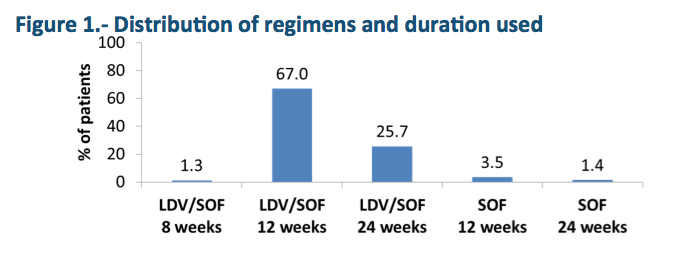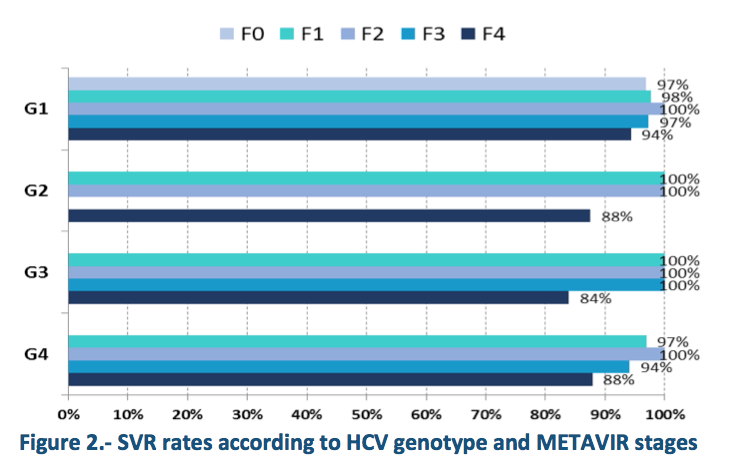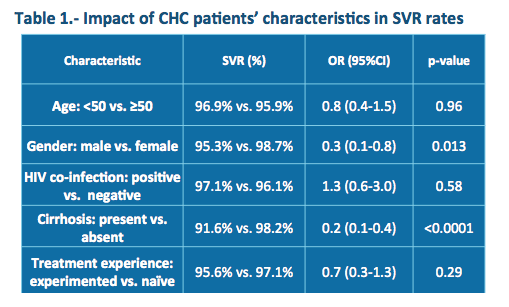 |
 |
 |
| |
Evidence of impressive real world SVR from the Portuguese ledipasvir/sofosbuvir and sofosbuvir universal coverage program to erradicate (eliminate) hepatitis C
|
| |
| |
Reported by Jules Levin
EASL 2016 April 14-17 Barcelona
Tato Marinho R1, Rodrigues J2, Martins J2, Mota-Filipe H2, Paula Martins A3, Andreozzi V4, Vandewalle B4, Félix J4, Castro Alves E2
1 Serviço de Gastrenterologia e Hepatologia, Hospital Santa Maria, Medical School of Lisbon, Portugal; 2 INFARMED - National Authority of Medicines and Health Products, I.P., Portugal; 3 Faculty of Pharmacy University of Lisbon, Portugal; 4 Exigo Consultores, Lisbon, Portugal
HCV Portugal Experience
"In February 2015 the Portuguese Ministry of Health initiated an ambitious policy granting universal and national access to LDV/SOF and SOF-based regimens for the treatment of all Portuguese patients with hepatitis C in the national registry, named Portal of Hepatitis C.....Our objective is to present, one year after the implementation of the program/strategy, for the very first time, real-world evidence on sustained virologic response (SVR) rates in a cohort including over a thousand of patients."
SUMMARY
In February 2015 the Portuguese Ministry of Health initiated an ambitious policy granting universal access to LDV/SOF and SOF regimens for the treatment of CHC. One year after of this policy implementation, there was information about treatment effectiveness for 1,069 patients (94% of which treated with LDV/SOF). The overall SVR rate was 96.3%. Patients with G1, non-cirrhotic and female presented higher SVR rates, and patients with G3, cirrhotic and male presented lower SVR rates. Age, HIV co-infection, and treatment experience did not significantly influence effectiveness. HCV G3 patients with cirrhosis and treatment-experienced presented a SVR of 86.1%.
CONCLUSION
Real-life data demonstrates that hepatitis C treatment with universal access to LDV/SOF and SOF-based regimens is associated with very high SVR rates, irrespective of HCV genotype involved. The most difficult patients to treat are those with G3 and cirrhosis, whom obtained response rates above 84%.
[....from Jules: one key story out of EASL 2016 is there were numerous reports from many countries like this one from Portugal reporting treatment results for thousands of patients including from France, Spain, Italy, UK where high SVR rates were reported, over 90% SVR rates, most 93-97%. At EASL new HCV treatment regimens were reported that include 2nd generation HCV drugs that will be more effective, that include 2 or 3 new 2nd generation HCV direct-acting antivirals, these studies report 99% SVR rates. These regimens are so potent, it will be very easy to eliminate HCV globally & certainly in the USA particularly with these new more potent regimens ONLY IF governments commit to doing this. In the USA we need federal and state governments to commit funding universal "Test & Treat" programs which include linkage to care. Globally companies, communities & local governments need to collaborate. In the USA insurer & state imposed restrictions have all too often prevented patients from accessing treatment unless patients had advanced HCV disease & these restrictions often do not allow injection drug users or even substance abusers to be treated, but we know that untreated HCV even in patients with very early HCV disease can lead to increased rates of various cancers particularly HCC, Hepatic Cellular Carcinoma, only early treatment prevents HCC, and we know substance abusers can successfully be treated, in HIV when ART was first approved back in 1996 it took 5 years for official allowance of IDUs to be treated, so insurers & both state & federal governments must recognize the HCV epidemic problem & decide to commit the funding & programs needed to "Eliminate HCV". This is the first time in the history of medicine as far as I know that we could cure a virus, nonetheless with only a 12 week course of treatment. History will not be kind to government officials who refuse to implement these programs.]
[from Jules: In the USA prices have come down quite a lot particularly recently where around $30 to $35k appears to be the cost for a course of treatment. Bear in mind HCV is a cure while in HIV ART treatment costs $15k annually for treatment but its a cost that persists forever, every year, because HIV is not curable, and then add on the healthcare costs for each patient over the course of their life with HIV, the cost is $500,000 in total for 30 years of treatment and associated healthcare costs. In NYS for example there are 57,000 in Medicaid with HCV, the cost to treat all of them is $2.5 Billion at the current drug costs but after you cure them all ongoing long-term healthcare costs are essentially eliminated; we spend in the USA $20 Billion every year for HIV Medicaid & Medicare. State governments could attempt to negotiate deals that include universal HCV screening & treatment & get better pricing from companies but federal & state governments are not doing this. History will not be kind to these officials. With the advent of new 2nd generation HCV drugs the time is NOW to begin these types of negotiations.]
[Portugal / Georgia Deals for HCV Drugs....http://www.natap.org/2015/HCV/122115_05.htm]

BACKGROUND
Ledipasvir/sofosbuvir (LDV/SOF) and sofosbuvir (SOF) represent the current standard treatment of chronic hepatitis C (CHC). Data from clinical trials present high rates of sustained virologic response (SVR), with some variation according to the subpopulation analyzed. In February 2015 the Portuguese Ministry of Health initiated an ambitious policy granting universal and national access to LDV/SOF and SOF-based regimens for the treatment of all Portuguese patients with hepatitis C in the national registry, named Portal of Hepatitis C.
OBJECTIVE
Our objective is to present, one year after the implementation of the program/strategy, for the very first time, real-world evidence on sustained virologic response (SVR) rates in a cohort including over a thousand of patients.
Materials & Methods
CHC patient demographics, history of liver disease (diagnosis, hepatitis C virus (HCV) genotype, METAVIR fibrosis score), and other clinical data (HIV coinfection, treatment history) were registered at cohort entry. Treatment options and duration, as well as clinical and virologic data were collected throughout treatment and at posttreatment follow-up. The cohort comprehended 8,856 patients with treatment authorization, of which 5,449 patients had initiated their treatment. This analysis concerns to the 1,069 patients with SVR assessment at the cut-off date of 31th of January 2016. SVR was defined as undetectable HCV RNA at 12 (SVR12) or 24 (SVR24) weeks after treatment completion. All data collected was validated and inconsistencies were censored. Chi-square and Fisher exact tests were used and 0.05 significance level was adopted. Odds ratio was also calculated as measure of association.

One year after of the universal access policy implementation, 1,069 patients had information about SVR12 or SVR24.

Mean (SD) age of these patients was 51.6 (10.1) years, with 9.1% in the class ≤40 years, 33.5% with 41-50 years, 35.9% with 51-60 years, 13.2% with 61-70 years, and 5.9% with <70 years (information was missing for 0.4%). The majority of these patients were male (71.4%). Regarding HCV genotype, 77.2% were G1, 1.6% were G2, 8.7% were G3, 12.4% were G4, and 0.1% were G5-6.

Additionally, 26.9% were HIV-positive and 44.4% were treatment-naïve. The majority of the patients (94.0%) was treated with LDV/SOF (Figure 1). The overall SVR rate was 96.3%. SVR rates according to HCV genotype and METAVIR stage are presented in Figure 2 and the impact of other patients' characteristics in SVR is presented in Table 1. Several subpopulations presented a response of 100%. Cirrhotic patients presented SVR varying between 84% and 94%, with G3 patients presenting the lower value. HCV G1 patients presented a statistically significant higher chance of presenting SVR compared to other genotypes (OR=2.6; 95%CI: 1.4-5.0; p-value=0.003), and G3 presented a 70% lower chance of presenting SVR versus other genotypes (OR=0.3; 95%CI: 0.1-0.7; p-value=0.003). Also for cirrhotic patients, the chance of presenting SVR was 80% lower than for non-cirrhotic patients (OR=0.2; 95%CI: 0.1-0.4; p-value<0.0001). Age, HIV co-infection, and treatment experience did not significantly influence effectiveness. HCV G3 patients with cirrhosis and treatment-experienced, a subpopulation historically difficult to treat, presented a SVR of 86.1%.

SUMMARY
In February 2015 the Portuguese Ministry of Health initiated an ambitious policy granting universal access to LDV/SOF and SOF regimens for the treatment of CHC. One year after of this policy implementation, there was information about treatment effectiveness for 1,069 patients (94% of which treated with LDV/SOF). The overall SVR rate was 96.3%. Patients with G1, non-cirrhotic and female presented higher SVR rates, and patients with G3, cirrhotic and male presented lower SVR rates. Age, HIV co-infection, and treatment experience did not significantly influence effectiveness. HCV G3 patients with cirrhosis and treatment-experienced presented a SVR of 86.1%.
CONCLUSION
Real-life data demonstrates that hepatitis C treatment with universal access to LDV/SOF and SOF-based regimens is associated with very high SVR rates, irrespective of HCV genotype involved. The most difficult patients to treat are those with G3 and cirrhosis, whom obtained response rates above 84%.
|
| |
|
 |
 |
|
|